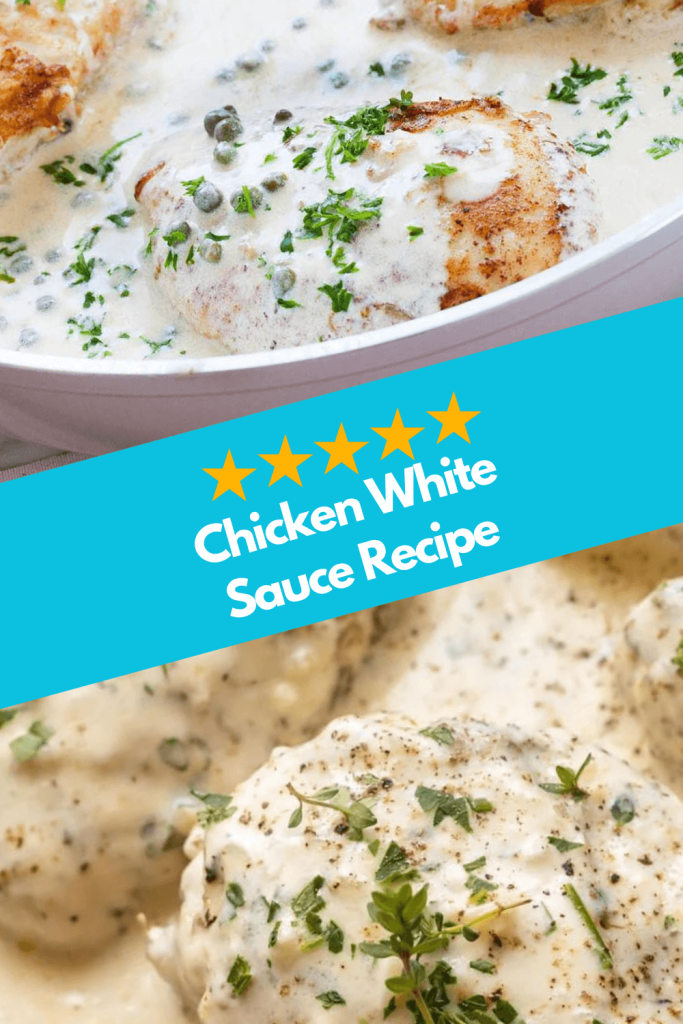This chicken white sauce is my secret weapon for turning simple chicken into a cozy, restaurant-worthy meal. I started making it years ago when I wanted to jazz up some grilled chicken breasts for a family dinner, and it was love at first bite. Creamy, garlicky, and just a little cheesy, it’s the kind of sauce that makes everyone ask for seconds. It’s perfect for drizzling over chicken, pasta, or veggies, and it comes together in minutes. Let’s get saucy!
Contents
Why You’ll Love This Recipe
This white sauce is smooth, rich, and packed with flavor, but it’s so easy to make. It’s ready in about 15 minutes, uses pantry staples, and elevates any chicken dish to the next level. I love how it transforms a basic meal into something special, and my family goes crazy for it. It’s also super versatile: add herbs, spices, or veggies to make it your own.
Ingredients
Here’s what you’ll need to make about 1.5 cups of sauce (serves 4-6):
- Butter: 3 tablespoons
- All-purpose flour: 3 tablespoons
- Chicken broth: 1 cup (low-sodium preferred)
- Heavy cream: 1/2 cup
- Parmesan cheese: 1/3 cup, grated
- Garlic: 2 cloves, minced
- Salt: 1/4 teaspoon
- Black pepper: 1/4 teaspoon
- Fresh parsley: 1 tablespoon, chopped (optional, for garnish)
Note: Freshly grated Parmesan melts better than pre-grated for a silky texture. If you want a lighter sauce, swap heavy cream for half-and-half, but it’ll be slightly less rich.
Equipment Needed
- Medium saucepan
- Whisk
- Measuring cups and spoons
- Garlic press or sharp knife
- Small bowl (optional, for broth)
Step-by-Step Instructions
This sauce is quick and simple but tastes like you put in way more effort. Here’s how I make it:
- Melt the Butter: In a medium saucepan over medium heat, melt the butter until it starts to bubble. I love that warm, buttery smell; it’s the start of something good!
- Make the Roux: Sprinkle in the flour and whisk constantly for 1-2 minutes to form a smooth paste. Keep stirring to avoid lumps; I’ve had a few sauce disasters when I got distracted! Cook until it’s a light golden color for the best flavor.
- Add Liquids: Slowly pour in the chicken broth, whisking to keep it smooth. Add the heavy cream and minced garlic, stirring until combined. Bring to a gentle simmer and cook for 2-3 minutes until it thickens slightly. The sauce starts looking so creamy here!
- Add Cheese and Season: Stir in the Parmesan, salt, and pepper. Simmer for another 1-2 minutes until the cheese melts and the sauce is velvety. Taste and adjust with more salt or a pinch of garlic powder if you want extra zing. I always sneak a spoonful to make sure it’s perfect.
- Serve: Pour the sauce into a serving bowl or drizzle directly over cooked chicken, pasta, or veggies. Sprinkle with parsley for a pop of color if you’re feeling fancy. Serve warm and soak up the compliments!
Tips for Success
- Whisk Constantly: A smooth roux is the key to a lump-free sauce. Don’t stop stirring when adding the broth and cream.
- Adjust Thickness: If the sauce is too thick, add a splash more broth. Too thin? Simmer a bit longer or add a pinch of flour mixed with water.
- Use Fresh Garlic: It gives a brighter flavor than garlic powder. I mince it fine so it melts into the sauce.
- Storage: Keep leftovers in an airtight container in the fridge for 3 days. Reheat gently on the stove with a splash of cream to smooth it out.
Serving Suggestions
This sauce is made for chicken but works with so much more. Here’s how I serve it:
- With Chicken: Drizzle over grilled, baked, or pan-seared chicken breasts or thighs.
- With Pasta: Toss with fettuccine or penne for a creamy Alfredo-style dish.
- With Veggies: Pour over steamed broccoli, asparagus, or roasted potatoes.
- For Guests: Serve with a side of garlic bread and a glass of white wine for a cozy, elegant meal.
Why This Recipe Works
The roux creates a thick, silky base, while the chicken broth and heavy cream add richness without being too heavy. Garlic and Parmesan bring savory depth, making the sauce versatile enough for chicken, pasta, or veggies. It’s a quick recipe that feels indulgent but is simple enough for weeknights. I’ve served this for family dinners and even date nights at home, and it’s always a hit.
FAQs
Can I use milk instead of cream?
Yes, but the sauce will be thinner. Use whole milk and add a bit more flour to the roux for thickness.
Can I make this ahead?
Sure! Make the sauce, cool it, and refrigerate for up to 24 hours. Reheat slowly on the stove, stirring in a splash of cream.
Can I freeze the sauce?
It’s best fresh, as cream sauces can separate when frozen. If you must, freeze for up to 1 month and reheat slowly, whisking well.
What if I don’t have Parmesan?
Romano or a Parmesan-Romano blend works, but avoid pre-grated cheese with additives, as it won’t melt as smoothly.
Final Thoughts
This chicken white sauce is my go-to for making any chicken dish feel like a special occasion. It’s creamy, garlicky, and so easy to whip up, perfect for busy weeknights or impressing your crew. Drizzle it over your favorite chicken recipe and watch everyone dig in. Try it out, and let me know how it turns out or what you serve it with!

